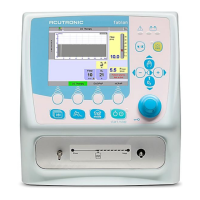When ventilating a patient using a nasal interface in nCPAP or DuoPAP
modes, the clinician must make a compromise between providing additional
flow to compensate for a leak at the nose, or providing an alarm to warn of a
leak, particularly when the appropriate size prongs are small. For a patient
who is capable of spontaneous breathing without support, leak
compensation may be set to a high setting, in order to provide additional
flow to compensate for a leak at the interface between the prongs and the
nose. This will provide a more stable pressure support in the presence of
variable leak (for example, with patient movement). However; in this
scenario, the ventilator may fail to provide an alarm is the event of
decannulation.
For a patient who requires an alarm in the event of decannulation, leak
compensation should be set to a low setting. This will provide less stable
pressure support in the presence of variable leak at the nose, but a reliable
alarm for decannulation.
If Inspiration time is set lower than 1 second, time maximum Pressure can
NOT be reached.
Depending on the Tube set, nCPAP Generator and Humidifier
O
2
Therapy mode
11.2.1 (High and Low flow oxygen therapy) HFNC
O
2
Therapy allows use of a continuous flow of blended gas, between 0 to 15 L/MIN in NEO and 0
to 30 L/min in PED mode. Nasal cannulas of various makes like F&P, Atom or similar can be used.
There are no alarm functions active in this mode, except for the set FiO
2
NOTE:
This mode can also be used to put the ventilator in Standby mode. By setting a Flow of 4
L/min, the humidifier dual servo temperature controls remain active, so no need to switch
it OFF in case of short-term Standby mode.
There are no patient alarms active in this mode

